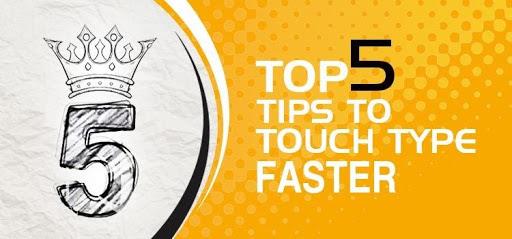
Touch typing is an excellent skill to possess as it helps you be more effective in communication and finish computer based work quickly, efficiently and on time. The learning process can be a little tasking as simply hitting the right keys isn’t quite enough. Even after learning the right typing techniques, you should still practice regularly to become better and more efficient with the keyboard. Follow these guidelines to improve your typing efficiency.
Touch Typing - A Detailed Guide for Typing Faster on a Keyboard
Learn the Basics
You cannot type faster without clarity on the basic concepts of touch typing. Increased speed demands proper coordination of mind (for keyboard recognition) and body (for fingers and muscles movements). You need to master the top, bottom and home row keys, along with the number pad. Use good software that guides you with exercises and helps you with tracking your progress.
Start practicing with letter sequences ASDF or JKL. Remember, FDSA and JKL; represent the ‘home row’ and learn the correct fingers to use for specific keys. Your fingers should return to the middle or home row after every keystroke. Virtual keyboards will highlight keys, which helps build muscle memory, for each and every finger. The letters F and J have small bumps which you can sense easily by touch, to identify the placement of fingers on the home row.
Learn to use the ‘rollover’ typing method only once you have successfully engrained finger position to muscle memory. This saves time, as you press the next key immediately after you release the previous key, and so on. To strengthen the connection between your brain and finger muscles keep your head looking at the screen and practice typing without looking at your hands. This way you spot typing errors easily.
To process commands quickly, use keyboard shortcuts. Here is a list of shortcuts you could use to save time:
Ctrl+C - Copy
Ctrl+X - Cut
Ctrl+V - Paste
Ctrl+Z - Undo
Ctrl+S - Save
Set Objectives
Set your goals and make daily targets. With regular practice, you will progress quickly but you also need to physically see your level of progress, after a few days of training. Make sure you set realistic goals, so they are achievable.
Prior to every training session, set primary and various secondary objectives. For example, tapping any key on the home row 20 times repeatedly without looking at your keyboard can be a primary motive. Learning the keys for the right and left hand can be an appropriate secondary objective.
Once you attain your goals, you can assess your improvement weekly. After easily attainable primary and secondary objectives, you should set more difficult goals, even if it requires extra effort. At this stage, you are least likely to get satisfaction from achieving easy goals so be creative when setting strong objectives.
Focus on Accuracy
As you learn the keyboard and increase your speed, try to focus more on accuracy. As you type quickly, you will make errors and to prevent this repeatedly happening, practice accuracy exercises. You should practice your typing technique slowly and perfectly rather than quickly and inaccurately. When it comes to developing speed, you should do this gradually and with practice.
The more you practice the more error-free content you will be type. You can proofread, read thoughts aloud to yourself and practice rollovers. People who type extremely fast have the least error rates as the skill is automatised and they instinctively know when, where, and how to press keys.
Maintain Correct Posture
Ensure a correct sitting posture. When you sit improperly, health issues such as Computer Vision Syndrome and RSI (Repetitive Strain Injury) are raised which can lead to backache and strain.
Take frequent breaks and perform finger exercises. Keep your spine straight, feet flat on the ground, shoulders relaxed, keep elbows at your sides and avoid resting wrists on your desk. If you type for several hours, use a typing chair or one that is ergonomic.
Correct sitting posture is essential as it is important to be comfortable whilst learning.
Be Patient
Patience is key when learning touch typing. Do not rush and in the initial stages take everything slowly. As your fingers build muscle memory your accuracy will improve and you will be able to type faster with fewer and/or no errors. It is better to type error-free content than typing with a lot of misspelled words as, returning to correct a typo will take longer than typing the word at a slower, more comfortable speed.
Accuracy is important. If you have patience, practice until you are capable of typing error free.
Touch typing will increase your productivity ten fold and is also pretty impressive for those watching too! Make learning fun, practice and keep focus and once you have learned this life skill you will never look back.
Copyright KAZ Type Limited 2025. KAZ is a registered trade mark of KAZ Type Limited.
Developed by : STERNIC Pvt. Ltd.